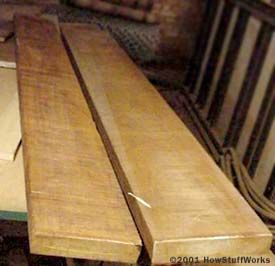A Solid Foundation
The table cabinet starts with a large, rectangular, wooden frame, typically made of thick hardwood planks. Usually, there are one or more cross beams, along with a center beam, to provide additional support to the slate. The frame is connected at the corners either with metal brackets or wooden blocks. The metal brackets or wooden blocks are placed in each corner and bolted to the planks, forming a very solid frame.
Depending on the size of the table, and the thickness and weight of the slate, there will be four, six or eight legs supporting the table. Some designer tables replace the legs with a large pedestal base. Table legs can be hollow or solid, although solid legs are the preferred choice. While the legs may just go to the bottom of the frame, most experts agree that solid legs that extend to the underside of the slate provide the best support.
Advertisement
A billiard table factory is essentially a specialized woodshop. The process goes like this:

The table cabinet normally falls into one of five categories:
- Laminate - MDF with a paper or plastic woodgrain glued on the exposed surface; normally found on inexpensive non-slate tables
- Wood Veneer - MDF or solid wood with a thin piece of hardwood glued to the exposed surface; found on inexpensive to moderate tables
- Wood-on-Wood - Quality hardwood glued on top of another type of wood; found on moderate to good-quality tables.
- Solid Hardwood - Entire cabinet made of quality hardwood, such as oak, tulipwood or mahogany; found on top-quality tables
- Metal-on-Wood - Sheets of metal, such as aluminum, attached to a wooden frame; found on commercial tables
Most billiard tables have drop pockets, which simply means that some type of net or container is under each pocket to catch the balls that fall into that pocket.
Some tables, particularly commercial tables, have a ball return.
